

Engers is a district of Neuwied on the right banks of the river Rhine in Germany located next to Koblenz in Rhineland-Palatinate.
Contents
Engers has 5,367 inhabitants. It is highwater-endangered by its direct contact with the river Rhine.


Engers is a district of Neuwied on the right banks of the river Rhine in Germany located next to Koblenz in Rhineland-Palatinate.
Engers has 5,367 inhabitants. It is highwater-endangered by its direct contact with the river Rhine.

A well known tourist attractions in the region of Neuwied and Koblenz is Schloss Engers. It was built around 1760 by Archbishop Johann Philipp von Walderdorff, as a summer-residence and hunting lodge. Today it is a popular touristic attraction for its music-events and touristic guidings.
The old city hall (built around 1642) and the princely inn "Schloss-Schenke" (built 1621) are placed directly in front of the Engers chateau.
Engers station was built 1869 as an importance junction for passenger and freight transport on the East Rhine Railway between Koblenz and Cologne.
Nocturnal guided walkings through the town are conducted twice a month. Their invention was a surprising success.
It's an old tradition of hikers using the trail Thuringia—Rhine to throw little stones from Thuringia into the Rhine at the Engers banks. [1]

Rhineland-Palatinate is a western state of Germany. It covers 19,846 km2 (7,663 sq mi) and has about 4.05 million residents. It is the ninth largest and sixth most populous of the sixteen states. Mainz is the capital and largest city. Other cities are Ludwigshafen am Rhein, Koblenz, Trier, Kaiserslautern, Worms and Neuwied. It is bordered by North Rhine-Westphalia, Saarland, Baden-Württemberg and Hesse and by France, Luxembourg and Belgium.
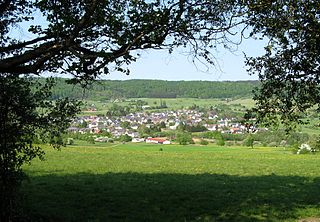
The Westerwald is a low mountain range on the right bank of the river Rhine in the German federal states of Rhineland-Palatinate, Hesse and North Rhine-Westphalia. It is a part of the Rhenish Massif. Its highest elevation, at 657 m above sea level, is the Fuchskaute in the High Westerwald.

The Moselle is a river that rises in the Vosges mountains and flows through north-eastern France and Luxembourg to western Germany. It is a left bank tributary of the Rhine, which it joins at Koblenz. A small part of Belgium is in its basin as it includes the Sauer and the Our.

Neuwied is a town in the north of the German state of Rhineland-Palatinate, capital of the District of Neuwied. Neuwied lies on the east bank of the Rhine, 12 km northwest of Koblenz, on the railway from Frankfurt am Main to Cologne. The town has 13 suburban administrative districts: Heimbach-Weis, Gladbach, Engers, Oberbieber, Niederbieber, Torney, Segendorf, Altwied, Block, Irlich, Feldkirchen, Heddesdorf and Rodenbach. The largest is Heimbach-Weis, with approximately 8000 inhabitants.
Mayen-Koblenz is a district (Kreis) in the north of Rhineland-Palatinate, Germany. Neighboring districts are Ahrweiler, Neuwied, Westerwaldkreis, district-free Koblenz, Rhein-Lahn, Rhein-Hunsrück, Cochem-Zell, and Vulkaneifel.
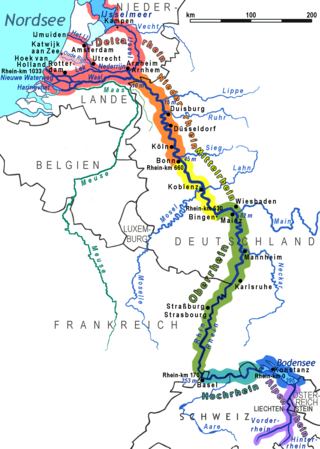
Between Bingen and Bonn, Germany, the river Rhine flows as the Middle Rhine through the Rhine Gorge, a formation created by erosion, which happened at about the same rate as an uplift in the region, leaving the river at about its original level, and the surrounding lands raised. This gorge is quite deep, about 130 metres (430 ft) from the top of the rocks down to the average water-line.

Bad Hönningen is a municipality in the district of Neuwied, in Rhineland-Palatinate, Germany. It is situated on the right bank of the Rhine, approx. 15 km (10 mi) northwest of Neuwied, and 30 km (20 mi) southeast of Bonn.

Caesar's bridges across the Rhine, the first two bridges on record to cross the Rhine river, were built by Julius Caesar and his legionaries during the Gallic War in 55 BC and 53 BC. Strategically successful, they are also considered masterpieces of military engineering.
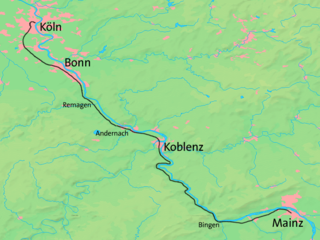
The West Rhine railway is a famously picturesque, double-track electrified railway line running for 185 km from Cologne via Bonn, Koblenz, and Bingen to Mainz. It is situated close to the western (left) bank of the river Rhine and mostly aligned to allow 160 km/h operation between Cologne and Koblenz and between Bingen and Mainz. Line speed between Koblenz and Bingen is restricted by the meandering nature of the Rhine Gorge, a UNESCO World Heritage Site.

The East Rhine Railway is a major, double-track, electrified railway line, running along the right bank of the Rhine from Cologne to Wiesbaden. The 179-kilometer (111.2 mi)-long line forms two Deutsche Bahn routes. Route 465 extends from Cologne to Koblenz, via Troisdorf, Bonn-Beuel, Unkel, and Neuwied. From Koblenz, Route 466 extends to Wiesbaden, via Rüdesheim am Rhein. Together with the Taunus railway, the line is used by Stadt-Express line SE-10 of the Rhine-Main Transport Association, which runs from Frankfurt to Koblenz and Neuwied.
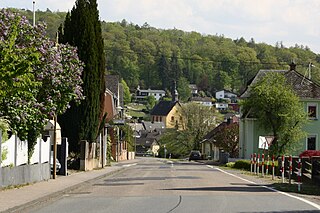
Hillscheid is an Ortsgemeinde – a community belonging to a Verbandsgemeinde – in the Westerwaldkreis in Rhineland-Palatinate, Germany.

Stolzenfels Castle is a former medieval fortress castle ("Burg") turned into a palace, near Koblenz on the left bank of the Rhine, in the state of Rhineland-Palatinate, Germany. Stolzenfels was a ruined 13th-century castle, gifted to the Prussian crown prince, Frederick William in 1823. He had it rebuilt as a 19th-century palace in Gothic Revival style. Today, it is part of the UNESCO World Heritage Site Upper Middle Rhine Valley.

Neuwied station is, along with Engers station, a hub of public transport in the town of Neuwied in the German state of Rhineland-Palatinate and it is located in its west. The station is located on the East Rhine Railway and is the starting point of the Neuwied–Koblenz railway. In the station forecourt there is a bus station. The station is classified by Deutsche Bahn as a category 3 station.
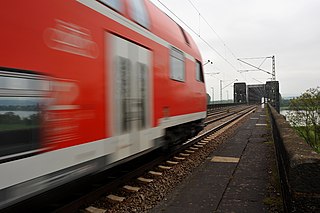
The Koblenz–Neuwied railway is a two-track, electrified main line railway in the German state of Rhineland-Palatinate. It connects the Neuwied station on the Right (east) Rhine line to the major railway junction at Koblenz Hauptbahnhof and to the Left (west) Rhine and Moselle lines.
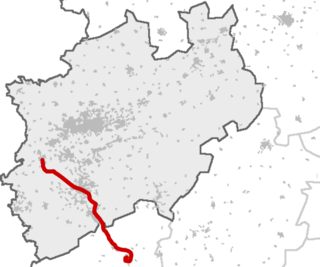
The Rhein-Erft-Express is a Regional-Express service in the German states of North Rhine-Westphalia and Rhineland-Palatinate. It is numbered as line RE 8 and connects the cities of Mönchengladbach, Cologne, Bonn and Koblenz with each other and their surroundings, running hourly. It is complemented by a Regionalbahn stopping service, the Rhein-Erft-Bahn, running also between Mönchengladbach Hauptbahnhof and Koblenz Hauptbahnhof. On weekends it stops at some additional stations between Cologne Hbf and Koblenz Hbf. It is operated by DB Regio with Alstom Coradia Continental EMUs.

Engers station is a through station and a former railway junction in the district of Engers in the town of Neuwied in the German state of Rhineland-Palatinate. It is on the East Rhine Railway and was formerly also the beginning of a line to Au (Sieg) and had a large freight yard.

Koblenz-Lützel station is the oldest still-operating station in the city of Koblenz in the German state of Rhineland-Palatinate. It was built at the same time as the Koblenz Rhenish station, which was abandoned in 1902 with the opening of the Koblenz Central Station (Hautptbahnhof) and destroyed in World War II.

Villa Musica is a foundation of the German state Rhineland-Palatinate and the broadcaster Südwestrundfunk. Its goals are to support young performers of classical music and to run concerts. It is based in Mainz at the Bastion Alexander. A second institute of the foundation, the Akademie für Kammermusik, is located at Schloss Engers in Neuwied.
Rüdiger Sterzenbach is a German economist and transportation scientist, sports official, CDU politician and a representative of a family of entrepreneurs. He was professor for economics and passenger transport management at Heilbronn University of Applied Sciences, former president of the regional sports federation of Rhineland-Palatinate "Landessportbund Rheinland-Pfalz", chairman of the regional sports foundation of Rhineland-Palatinate "Sporthilfe Rheinland-Pfalz/Saarland" and economic policy spokesman for the CDU Rhineland-Palatinate. His father was a factory worker, his mother was a housewife. He is married and has two grown sons.

Schloss Engers is a Baroque-style palace in Engers, near Koblenz, Germany. It is situated on the banks of the Rhine river. Johann IX Philipp von Walderdorff (1701–1768), Prince-Elector of Trier, constructed the palace between 1759 and 1764 based on a design by the architect Johanness Seiz. It served both as summer palace and hunting lodge.